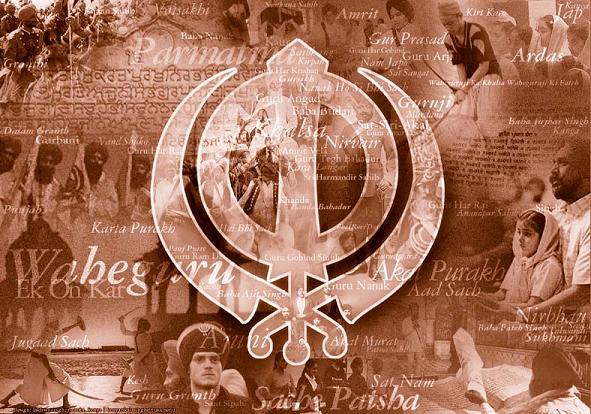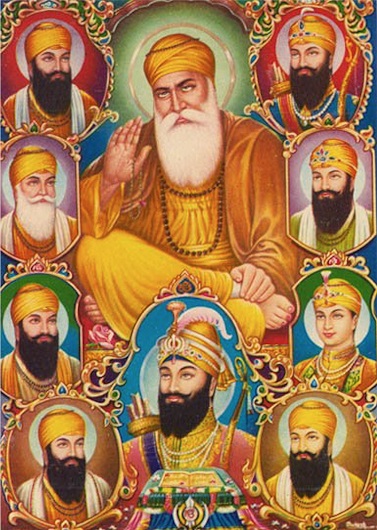
Amrit
Dr. Kulwant Singh Khokhar

Amrit - the Holy Drink Also read Baisakhi 99
Duplication has not been reduced in this write-up to leave it independently complete.
Amrit Defined
Amrit is very important in the Sikh faith, and it needs a little more elaboration. It is literally a drink bestowing eternal life: immortality -
ਅੰਮ੍ਰਿਤੁ ਹਰਿ ਪੀਵਤੇ ਸਦਾ ਥਿਰੁ ਥੀਵਤੇ ਬਿਖੈ ਬਨੁ ਫੀਕਾ ਜਾਨਿਆ ॥
Amr;it.u Har-e peevat.ae sad.aa thiru theevat.ae bikhaae banu pheekaa jaaneaa
They become immortal by drinking the Amrit of the Lord and vices lure them no more.
5-81-1
(In fact, here Amrit means Naam-Jaap - reciting God's name)
Amrit has spiritual as well as, physical aspects. Spiritually speaking, Amrit is the Name of God and its recitation. Physically, it is a special drink, but it is meant for the spiritual growth. The aim of recitation of the name of God and of drinking 'Amrit,' is the same. Amrit is meant to put a fellow to the Naam-Jaap - recitation of His name.
'Amrit' is the cherished desire common both to the Guru and his Sikhs. The Guru desires the disciple to take it, and one who is fully oriented to the faith, becomes keen to do so. Taking Amrit is the Sikh Way of getting inducted into this Faith. Drinking Amrit is a vow to live an elevated life and to do the Naam-Jaap.
Amrit - Preparation
It is prepared by Five Faithful (Panj Piarae - Five-Beloved of the Guru - Amritdhari Sikhs). Women can take part. After Ardas (Invocation), sugar cakes (Patasae, patashae pqwsy) are put in an iron bowl and are dissolved in the water taken preferably from a river or a well. The hand pumps, or taps used to have leather washers and the leather was from the hide of animals like cows or buffaloes. Now, mostly the plastic is used. All five persons focus on the Amrit and place their hands on the Bata (Bowl). With full concentration, these five Sikhs in turn recite the specific five (5) Gurbanis - Scriptures. The other four give their company in the recitation.
Banis - Scriptures
The following 5 Scriptures are recited when preparing Amrit -
- Jappu -Jappu ji Sahib, Bani Of Guru Nanak Dev.
- Jaap - Jaap Sahib, Bani of Guru Gobind Singh.
- T.av-Parsaad - Bani of Guru Gobind Singh
- Chaupai - Bani of Guru Gobind Singh
- Anand Sahib - Bani of Guru Amar Das
They continuously work Khanda (Double edged sword) to and fro in the bowl, while reciting Gurbanis. Amrit is given to drink to the person or persons gathered to get inducted into the Sikh-Faith. They pledge to live a high ethical life according to the Reht (Edicts - dictates) of Amrit i.e. its discipline.
Amrit - Edicts
Things that should be taken care of -
- Jaap and Bani - Naam-Jaap - recitation of the word `Waheguru;' Mool-Mantar Jaap; Nit-Nem - routine recitation of the prescribed Scriptures; Recitation of Guru Granth Sahib. He or she has to read or recite Scriptures and remember God.
- High Class Living - Ethical living, honest earning, sharing with the needy, Sewa (Selfless service), universal selfless love, helping others, compassion, indiscrimination etc.
- Kakkaars - To observe the Five Kakkaars (5 Ks) - On accepting Amrit, it is the promise of the Sikh to keep these 5 things on body and never to discard these: Kaes, Kangha, Karra, Kachh, Kirpan -

The revelation of the order of Khalsa (pragtio Khalsa) was the climax of all that had gone before and the inspiration of all that was to follow.
Two hundred years after Guru Nanak (1469-1539) laid down the founding precepts for New Age ideology and institutions, Guru Gobind Singh completed that mission on the Vaisakhi day in 1699.
- Kaes (Kaesh) - Unshorn hair to keep the appearance distinct and dignified. The head (Hair) must always be kept covered by everyone, with any sort of cloth, in any style. Mostly, the males tie turbans, and women use a length of cloth. Caps and hats are not allowed. Kaeski or Dastar is short length cloth wrapped around the head.
- Kangha - Comb, to keep the hair tidy.
- Karra - Bangle. A heavy, iron-bangle worn on the right wrist. It is to remind the pledge to the Guru at the time of partaking Amrit - to live a high ethical life. It is a blunt weapon, too.
- Kachhaa - A knee-length underwear of standard specifications that tight fits just above the knees (Should not go below them). It is a cloth fit in war and peace. This reminds of the self-control, as well.
- Kirpan - Dagger like semi-curved sharp weapon. Its small version is always kept on the body, for self-defense. It is symbolic of courage and of holding the faith in very high esteem. Its supreme value in this atomic age and ever after, is that of a Symbol.
The names of these five items start with letter Kakkaa k k of the Gurmukhi script, equivalent to the Roman K and so, these are called Five (5) Kakkaars, known in the oversea countries as 5 Ks. Once accepted (promised) these are never to be discarded.
Transgressions
An Amritdhari Sikh shall not do the following -
Serious Transgressions - Bajjar-Kurehtaan. An Amritdhari is to carefully protect him or her from these four serious violations -
- Hair - Cutting or removal of hair from any part of body by any means, is not permitted.
- Tobacco - Tobacco in any form is strictly prohibited.Sex - Out of marriage sex was prohibited to the Sikhs. They were to respect every woman. They were to honor even the enemy's women, and send them to their homes with respect.
- Meat - In view of the self-respect and to maintain individuality, the Sikhs were to consume meat prepared by Jhatkaa, in which neck of the animal is severed with a single stroke of a sharp weapon. They were not to eat any other meat including Halal.
Some modulations (Sub-transgressions) of the serious offences are also, tagged to these four main violations.
Amrit
Giving of Amrit was established on the Baisakhi day of 1699, by the Tenth Master Guru Gobind Singh, to give his final seal to the Perfect Man: the Khalsa. It was to be a force to protect the faith, its edicts, and the needy. Its edicts are essential for the balanced evolution of the spiritual and social obligations of the high order.
Amritdhari, those who have taken Amrit, have to daily recite or read the five prescribed Banis (Prayers - Jappu ji, Jaap, Sva-ee-ae, Rehras, Sohla or Kirtan Sohela), practice the Naam-Jaap, and read a portion of Guru Granth Sahib (the Holy Book). They should have an honest avocation, take out Dasvandh (Tithe - 1/10th of their income) for charity, and for the projects of the faith and humanity. They should not take intoxicants, and should restrict sex to their marriage. They have also to abide by other teachings of the faith to live an honest, God-oriented, and high-class life.
Importance of Amrit in the Naam-Jaap is that at the time of accepting it, the recipient is ordained to do the Jaap of Gur-Mantar 'Waheguru,' and of 'Mool-Mantar,' given at the start of Jappu ji.
Accepting Amrit is a promise of the high order with the Guru, and it should be taken seriously. It should not be given to a child just out of fun. One should take it only when one is mentally fully prepared to live its edicts. If you have not taken Amrit, born in a Sikh family or not, observe its Reht i.e. 5Ks. etc. or not, abide by the Sikh-Philosophy - faith in One God, the Sikh Gurus, Guru Granth Sahib and their teachings.
Patit Sikh -
A defiled Sikh.No Sikh can be Patit, because he or she can get his fault redressed by repentance at Akal Takht, or before 5 Amritdhari Sikhs, by re-taking Amrit, and serving the (token) punishment. A serious fault should not include an unintentional omission or commission. Ordinary faults are dealt with Parshad, Ardas, and may be a little Sewa (service) or fine by Akal Takht or Panj Piarae.
Baptism -
Taking Amrit is not Baptism. Baptism is a Christian ceremony. We may say, 'Amrit, a Baptism-like ceremony.' We should try to introduce right words to the people.
There is a legend that Guru Gobind Singh waits for his Sikh to take Amrit and visit the Guru's last resort, Sachkhand Nander - Sri Hazoor Sahib (In Hydrabad Deccan, India), up to his or her age of 60 years.
Sikhism.
A special note - The word `Sikhism' is the misnomer, because the Sikh faith is not merely a theoretical `ism,' but is a practical way of life. It is to live the faith. Right and better word to replace `Sikhism' is `Sikhi.' It is not a difficult word, and there should not be any problem in using it.
Name -
The first name of a Sikh ends with `Singh' for men and `Kaur' for women. `Singh' and `Kaur' are `identities' of the Sikhs, and are gifts from the Guru. Calling children with their half names, short names, and nicknames, is another thing. Using such names for adults is in no way something great. Cutting off `Singh' or `Kaur' from the Sikh Names, or distorting these is sad. The Gurus and devoted Sikhs sacrificed their precious lives for their names. They were tortured to death because they were Singhs and Kaurs. A Sikh should value his or her heritage.

